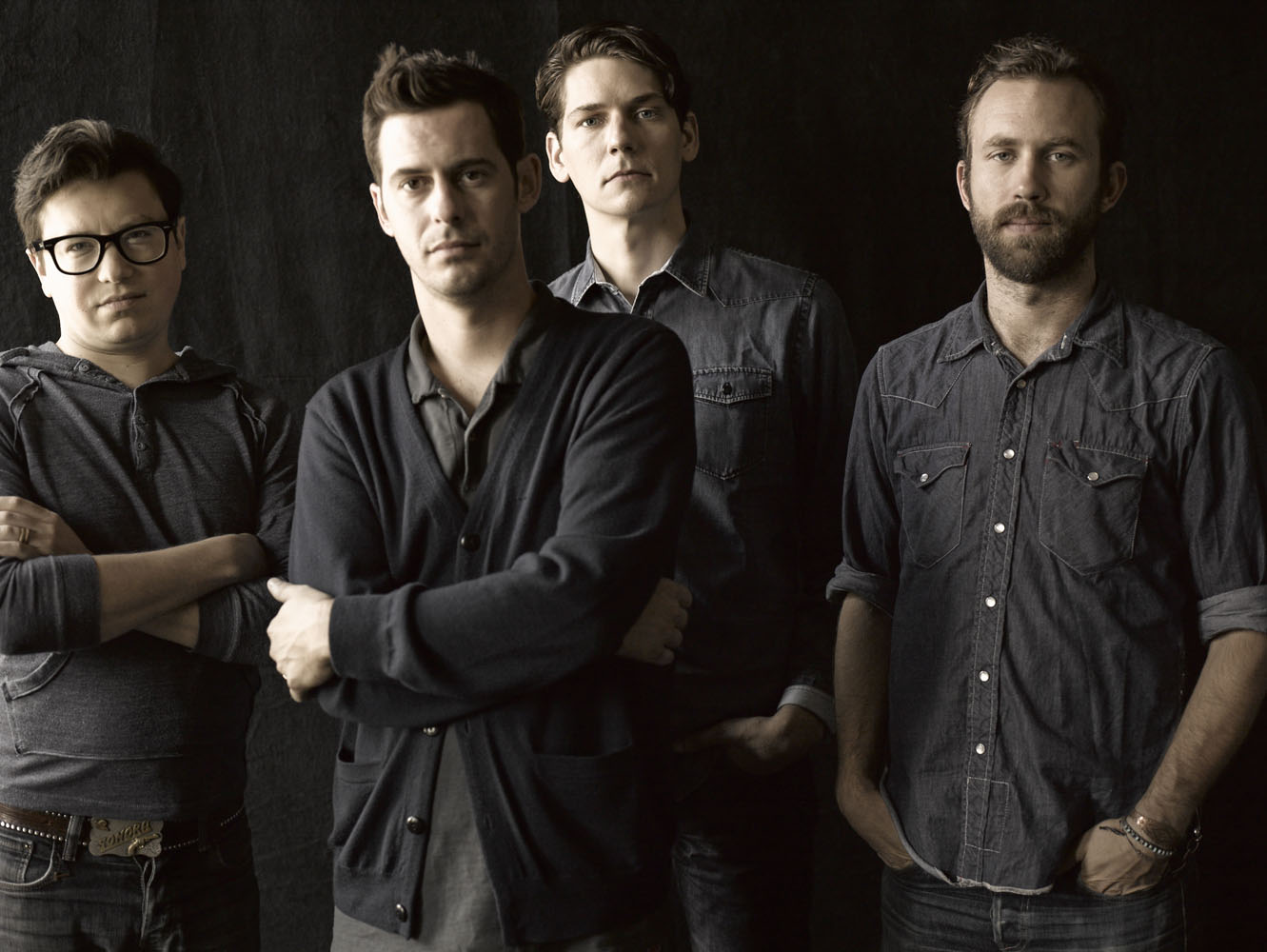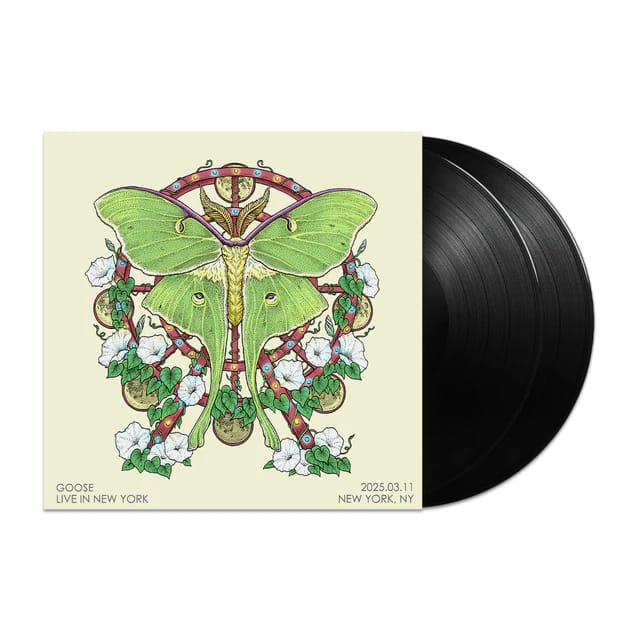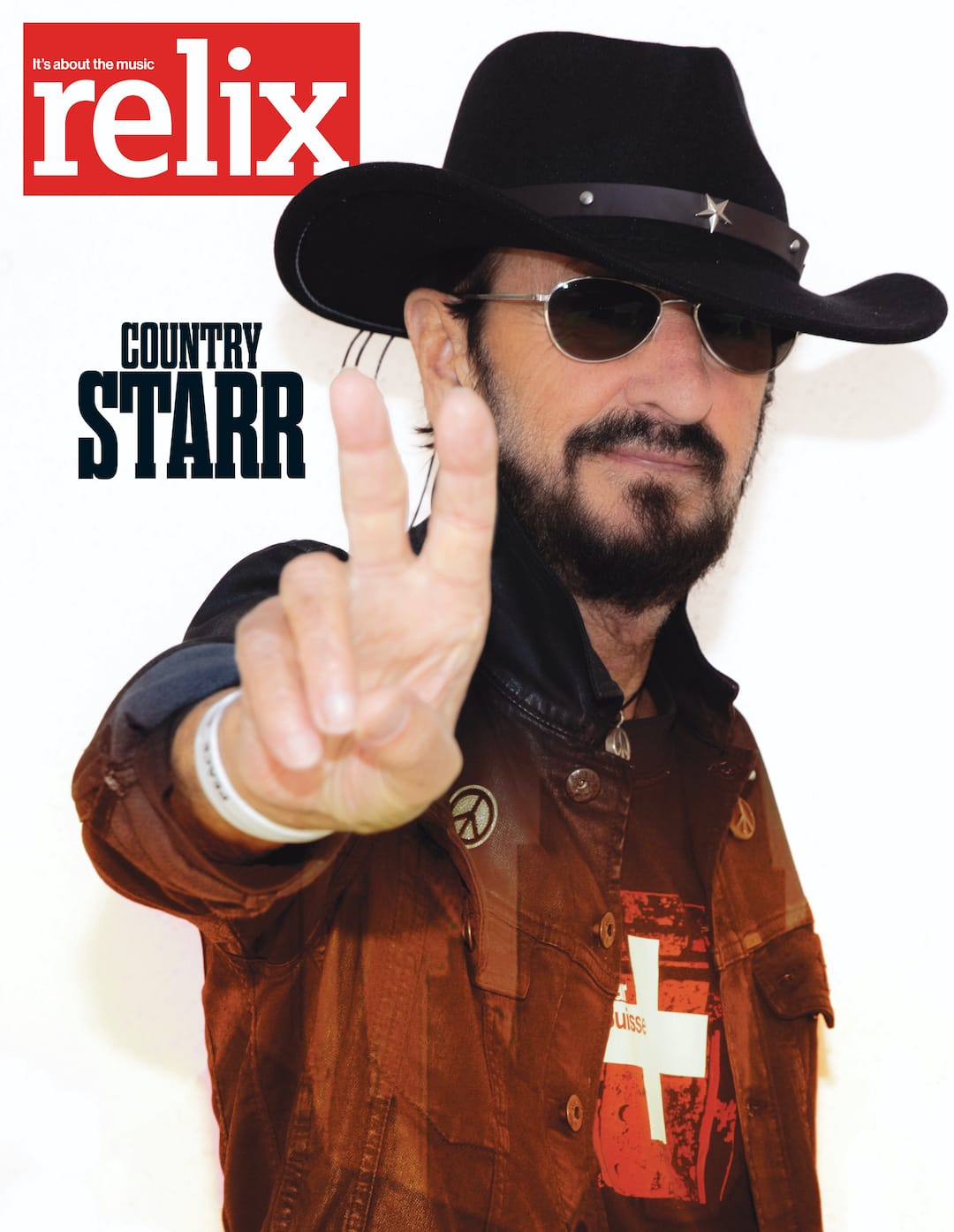White Denim: The Music is the Message

James Petralli doesn’t look like a rock star. Slouched in a dark booth in Los Angeles’ 101 Coffee Shop, a brown-tinged, aging diner frequented by incognito celebrities and Hollywood hipsters, the singer and guitarist of the Austin, Texas band White Denim could be anyone. Although Petralli’s hair has been varying lengths throughout the group’s career, he’s now mostly clean-cut, clad in black-rimmed glasses and a basic T-shirt. He and his wife had their first daughter in January, and Petralli’s only vice seems to be a stubbed-out cigarette butt he leaves in a tree outside the diner doors when he can’t find a garbage can.
His bandmates—drummer Joshua Block, bassist Steven Terebecki and guitarist Austin Jenkins—sit in a nearby booth with several of their crew members. The band has arrived in LA primarily to open for The Flaming Lips and Tame Impala at the Greek Theatre, but are augmenting the visit with a second show with Tame Impala at the downtown Belasco Theater the following evening. White Denim’s latest album, Corsicana Lemonade, is out today, the follow-up to 2011’s D, and the band is already receiving accolades for the 10 surging rock songs on the disc.
“This is probably the most direct album that we’ve ever made in every aspect,” Petralli concludes after nearly an hour of reflecting on its creation. “The performances are really direct. The lyrics might not be as direct as some things but for me, they’re more so than I would generally write. This record is us maybe trying to be more giving.”
Corsicana Lemonade is almost entirely a product of 2013—a fact that is surprising for White Denim, who spent two years working on D. The musicians first started considering the next record shortly after D’s release, shifting through various writing sessions and thematic ideas before deciding they needed to begin with a clean slate. The band had written D over the course of several tours, performing the songs live as they created them, so by the time that album emerged, there was a sense of fatigue associated with the music. They didn’t want that to happen so quickly with the next one. “Three records have been conceived since D,” Petralli says. “We just decided to postpone work on the other stuff.”
The album began when the musicians spent four days in Jeff Tweedy’s Chicago studio The Loft in March. White Denim had opened for Wilco during an intense West Coast tour and bonded immediately. Tweedy is the one who suggested he helm some songs for the group, a casual aside that transformed into a real session. Though Petralli sees the connection between White Denim and Wilco as primarily being the fact that everyone in both bands seriously cares about their playing, he’s not entirely certain how it all transpired.
“I think us being pretty well- versed about what they did there and showing that interest and engaging with them about that kind of thing led to them opening up a little bit more,” he says. “And, ultimately, to the invitation.”
White Denim showed up in Chicago with two songs, neither of which they had rehearsed or played for Tweedy beforehand. There wasn’t a real plan except to record. “I think Jeff thought we were going to make an entire record in four days,” Petralli says. “Low did that [with the] record they made a month before. They came in and made a beautiful record in four days.”
The two tracks, “Distant Relative Salute” and “A Place to Start,” came quickly and the band spent the remaining two and a half days messing around with Wilco’s sizeable collection of esoteric instruments. The band would suggest an old synthesizer or a piece of gear to the studio manager and 20 minutes later, he’d arrive back in The Loft, which Petralli describes as a “sprawling warehouse space,” armed with a laboratory of toys for the musicians to play with. The resulting material didn’t make the album, but Petralli feels like they’ll “do something with it eventually.”
“We had such a crazy collection of instruments there that we just did these linear one-chord grooves,” he says. “We pulled out tons of different synthesizers, tons of different guitars, their Mellotron. They have some really cool stuff. Anything that we could think of, we were just asking about it.”
White Denim translated The Loft’s concept into their own space after leaving Chicago. The band rented a house in Austin’s lake country, some miles west of downtown, and used it as a custom studio for a month. The goal was to replicate Tweedy’s setup, which involved purchasing a Mellotron and filling the room with 10 or so keyboards. Block found a mobile recording desk online that was used in the 1972 Munich Olympics and had it shipped from the Netherlands. With the help of Ryan Joseph, owner of Austin’s 5th Street Studios, where White Denim had laid down D, the lake house became an armory filled with gear. For the musicians, these unique instruments acted not as an impetus to write songs but as a way to pull them together.
“The gear provides a nice common ground for everybody in the group,” Petralli says. “It’s something that’s really concrete. It’s something that everybody can understand and get into, and it kind of dictates what you’re going to do with your instrument. In that regard, I think it definitely has a lot to do with how the songs end up for the consumer. I wouldn’t say that it really affects the writing all that much, although it can in that regard as well. Sometimes instruments come with song. People say that and it’s true. Fuzz from the old board the engineer brought in definitely birthed a couple of solos.”
They laid down the songs in the house with producer Jim Vollentine, and unintentionally divided them into two sides. The heavier tracks, which comprise Corsicana Lemonade’s first five songs, are the result of Block, Terebecki and Jenkins fiddling with arrangements together. Petralli birthed the other five on acoustic guitar. From a musicianship angle, the vision was to complete something straightforward in its complexity, a sensibility that you can hear on the album. The songs revel in sprawling electric guitar riffs and static-laced melodies, building epic rock and roll numbers with psych-rock and Southern tendencies. They tracked the entire album live, marking the first time that White Denim has done that in the studio.
“We just wanted to play together live and see how clear and direct we could be,” Block says after he and the other band members join Petralli in the dark booth. “That’s what I felt like. I wanted to be more direct personally because I always enjoyed the sound of guitar records or music when it’s just really happening in front of you, and when you’re listening to it, you can picture what the hell is going on.”
Jenkins, who joined White Denim four years ago and rounded out their initial trio, elaborates, “It’s almost like you put things more into focus when you limit what’s going on. You have to really be concise and right-on with what you’re doing, if that makes any sense. It’s like practicing. You can’t practice everything at the same time. You have to isolate certain ideas. Once we did that—isolating what we were going to do—it felt right.”
Block adds: “Instead of trying to whittle your peg to fit in a hole that’s already been recorded, we were all trying to make the same shape.”
When Petralli was in college, he made a short film called Sauce Bath. The movie was an interpretation of a 1964 performance-art piece by Carolee Schneemann that mingled human bodies with raw fish, chickens, sausages and wet paint, among other materials. The show had several performances, initially at the first Festival of Free Expression at the American Center in Paris, and it meditated on the body and erotic rites. Petralli created his own version, which he presented to a sociology class. “I showed the movie and then, I gave a whole presentation to the classroom, and every metaphor that I put in the movie, I completely laid out,” he says. “At the end of it, the teacher was like, ‘I would have given you an A if you had just shown the video.’”
Ever since, the musician has tried not to explain his art. He keeps the inspiration behind White Denim’s lyrics to himself and won’t elaborate on the cohesive narrative threads that draw the songs on Corsicana Lemonade together. According to Petralli, “the band doesn’t even really know [their meaning],” a fact that may shift the overall understanding of White Denim’s music. The singer says that fans “very rarely” talk to him about his lyrics, and few people ever offer him their own interpretations. The words on unofficial lyric sites are riddled with errors, and for that reason, this album features a lyric sheet for the first time since White Denim’s 2008 debut Workout Holiday.
“I’ve always really tried to push the emphasis on the band,” he says. “Maybe that’s worked. Or maybe the things I say are more oblique than people are ready for. I don’t think music and lyrics are mutually exclusive. I listen to a lot of Japanese and Italian and Greek rock and roll and I have no idea what it means, but I can feel it. There’s emotional content in everything that’s on the recording and we definitely hope that translates.”
Petralli’s favorite art contains an element of mystery or uncertainty. When pressed, he cites Flemish Renaissance painter Pieter Bruegel, Alfred Hitchcock and Gertrude Stein as some of his favorites, pausing to add that he could include John Coltrane’s “more spiritual stuff.” As an observer and artist himself, the musician says he’s looking for “melodies and chords that don’t always perfectly line up and resolve.” He has a desire to withhold, something that the rest of the band doesn’t share, and Corsicana Lemonade represents a true shift for Petralli toward a more direct style of songwriting. Some numbers, like the gritty, blues-tinged rocker “Limited By Stature” and the title track, feel obvious for the musician, who says he hasn’t veiled everything in metaphor there. But when listening to White Denim, there is a real sense that the music itself overrides the lyrics, and the emotion comes through largely in instrumentation.
The emphasis on the music has earned White Denim the status of being a band that improvises, but that reputation has been exaggerated and mutated as it’s been shared over the past few years. “People think that we improvise a lot more than we do,” Petralli says. “I’ve said it a hundred times and people still write it: ‘electric improvisation.’ I think it’s because we connect songs; we do medleys. Really all of us saw Sly & the Family Stone do those late night performances where they’d play all of their hits in a 10-minute go and it was a really awesome presentation. We started doing that on the second record, just partly because I don’t really like to talk to the audience very much.”
The live show, which often extends over two hours during headlining gigs, hinges upon several 30-minute segments of music, each song gliding into the next. The compositions have shifted from their recorded versions in some ways, but according to the musicians, White Denim, at least in the traditional sense, is only improvising about 10-20 percent of the time onstage. “We don’t really vamp,” Petralli adds. “There aren’t a lot of opportunities for that. You can really tell when people are straight improvising and I don’t think any of us feel comfortable just sitting in a funky groove on one chord. We don’t want to do that. We don’t want to be that kind of band.”
Despite their relatively deep catalog, White Denim does not play a lot of songs off their first three albums live. Many tracks can’t be recreated or rewritten or the band refuses to do so out of consideration for the songs’ integrity. In some cases, it is simply because tunes written on a piano can’t be played without a piano or that a certain song would require two bassists. There’s enough music in their catalog that this tends not to matter live, particularly when White Denim only have a 30-minute opening slot on The Flaming Lips’ tour, but the musicians wanted to make sure that most of Corsicana Lemonade could make its way onstage. The band has been touring with many of the songs since this past summer, debuting a lot of the music far ahead of the album release. They spent a few weeks rehearsing, but the fact that they tracked the album live readily prepared the songs for the road.
“On our old records, sometimes [the process] would happen over a year or longer,” Terebecki notes of arranging the material for the live setting. “This happened over four weeks. So that time span makes it cohesive. Everything’s still where it was a week ago, whereas in a two-year period, a lot of things change.”
“It puts more emphasis [on] knowing what you’re going to do before you get in there and lay it to tape,” Jenkins adds. “Instead of reverse engineering the idea, we’d see where it felt good and then all get together and play it instead of trying to change the feel after.”
Corsicana Lemonade has a Side A and Side B, but White Denim initially refused to present it that way. They wanted the songs, created with separate methodologies and different producers, to flow seamlessly. The band’s 2009 album Fits featured two distinct sides, each with its own aesthetic, and White Denim hesitated to repeat that here. Joe LaPorta, the engineer who mastered the album, changed their minds.
“Everybody in the band had a different idea of the order and we couldn’t really agree, so we just decided to let somebody else decide,” Petralli says. “And [Joe] picked it right down the middle the way we were thinking we should avoid. But an outsider said, ‘This is the best way to do it.’ We came around to it. We all sat down and listened to it in that order and agreed that it does work.”
Now that the musicians have been performing the new songs live for a few months, they feel that these new numbers connect to old songs rather than solely to each other. The live show, which White Denim is redeveloping for a six-week headlining tour that will kick off on January 27 in Denver, Colo., is about creating bridges between what the band has done and what they are doing now. Despite wiping the slate clean prior to Corsicana Lemonade, the group wants to maintain continuity between the work they did following D and going into the studio with Tweedy. That music will still get its due. Although it will be revealed out of time chronologically, thematically, Petralli feels like it will make more sense later.
“I just think it wasn’t the right time for that,” he says. “There is a much bigger collective interest in doing something new together. Some of those songs have been around for three years already. There’s a musical theme, they’re all the same key and it felt a lot more like a concept thing. It would have been a statement I don’t think everybody was super excited to make. I know that I wasn’t. I like that, but I’d rather do it as, ‘Hey, there’s also this,’ rather than have it be the next record that we’re working on for two years and have to answer to in that way. There’s a certain amount of responsibility that we all feel when we put out a record the way we’re putting this one out.”
Petralli and his bandmates leave shortly after finishing lunch at the 101 to head to the Greek Theatre, cigarettes dangling from their fingers. Even after a long conversation regarding their music, it’s hard to say how much they have revealed about it. Perhaps that’s best—it would be a shame for Petralli to overanalyze his art the way he did with Sauce Bath. Ultimately, for White Denim, the music is the message.




















